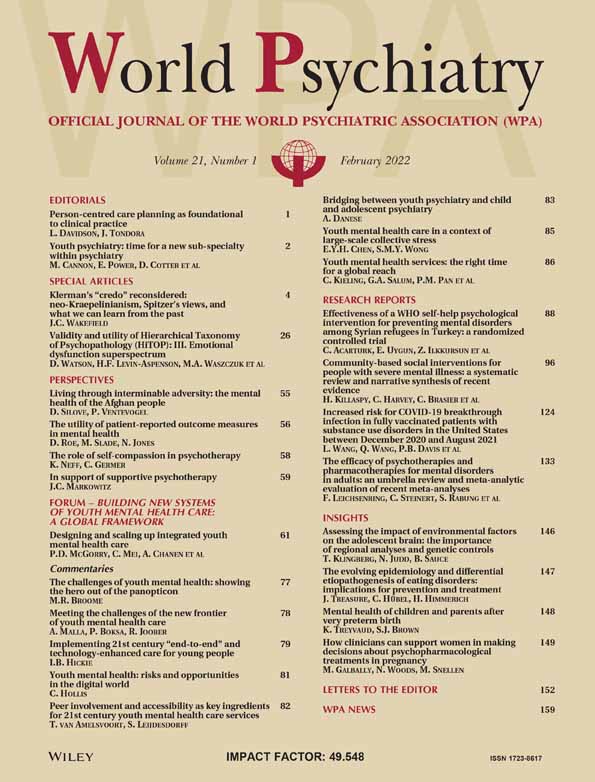ICD-11躯体痛苦障碍和DSM-5躯体症状障碍在世界精神卫生调查倡议下新的大规模人口调查中的流行病学
IF 65.8
1区 医学
Q1 Medicine
引用次数: 0
摘要
令人痛苦的躯体症状是常见和致残的,但缺乏可靠的潜在疾病分类限制了我们对其人口负担程度的理解。ICD-11中的躯体痛苦障碍(BDD)和DSM-5中的躯体症状障碍(SSD)的新分类旨在解决先前概念化的根本弱点,但在其标准规范上存在重要差异。在社会和文化多样化的环境中,在世界精神卫生调查倡议范围内进行了三次新的大规模人口调查,为解决人口患病率、精神和身体健康相关因素以及与BDD和SSD的作用受损的关系等问题提供了机会。WMH调查在香港、菲律宾和卡塔尔有代表性的成人家庭样本中进行(合计N=18,105名受访者)。多变量回归分析检验了BDD和SSD与社会人口统计学变量、共病DSM-5精神障碍和慢性身体状况的关系。通过检查访谈前30天中与健康相关的角色缺勤天数(DOR)的平均数量,调整社会人口统计学变量和合并症,评估角色损害。三种情况下,BDD的点患病率为2.0%,SSD为3.5%,两种诊断均为4.1%。BDD,特别是SSD的点患病率在香港最高,这表明文化和社会因素的作用。女性达到这两种障碍标准的可能性是男性的两倍。患病率随着年龄的增长而增加。BDD和SSD与广泛性焦虑、恐慌、创伤后应激、重度抑郁和双相情感障碍显著相关,且BDD的相关性始终强于SSD。常见的慢性身体疾病(关节炎、哮喘、糖尿病、高血压和胃溃疡或肠道溃疡)的合并症更为轻微。调整共病精神障碍和慢性身体状况后,BDD和SSD均与平均DOR增加显著相关,但仅BDD组的调整后平均DOR显著高于仅SSD组(4.7 vs 3.1, p<0.001)。这些发现证明了BDD和SSD对公共卫生的高度重要性。尽管两者在社区中并不十分普遍,但它们与常见的身体和精神障碍的共同发生,以及它们与角色损害显著相关的事实,为临床关注提供了强有力的理由。本文章由计算机程序翻译,如有差异,请以英文原文为准。
The epidemiology of ICD-11 bodily distress disorder and DSM-5 somatic symptom disorder in new large-scale population surveys within the World Mental Health Survey Initiative.
Distressing somatic symptoms are common and disabling, but a lack of reliable classification of the underlying disorders has limited our understanding of the extent of their population burden. The new categories of bodily distress disorder (BDD) in the ICD-11 and somatic symptom disorder (SSD) in the DSM-5 were designed to address the fundamental weaknesses of previous conceptualizations, but have important differences in their criteria specifications. Three new large-scale population surveys within the World Mental Health (WMH) Survey Initiative, conducted in socially and culturally diverse settings, provide the opportunity to address questions regarding population prevalence, mental and physical health correlates, and associations with role impairment of BDD and SSD. WMH surveys were carried out in representative household samples of adults in Hong Kong, the Philippines, and Qatar (combined N=18,105 respondents). Multivariable regression analysis examined associations of BDD and SSD with socio-demographic variables, comorbid DSM-5 mental disorders, and chronic physical conditions. Role impairment was assessed by examining the mean number of health-related days out of role (DOR) in the 30 days before the interview, adjusting for socio-demographic variables and comorbidities. The point prevalence across the three settings was 2.0% for BDD, 3.5% for SSD, and 4.1% for either diagnosis. The point prevalence of BDD and especially of SSD was highest in Hong Kong, suggesting a role of cultural and social factors. Females were twice as likely as males to meet the criteria for either disorder. Prevalence increased with age. BDD and SSD were significantly associated with generalized anxiety, panic, post-traumatic stress, major depressive, and bipolar spectrum disorders, and associations were consistently stronger for BDD than SSD. More modest comorbidities were found with common chronic physical conditions (arthritis, asthma, diabetes mellitus, hypertension, and stomach or intestinal ulcer). BDD and SSD were both significantly associated with increased mean DOR after adjusting for comorbid mental disorders and chronic physical conditions, but the adjusted mean DOR was significantly higher in the BDD-only than in the SSD-only subsample (4.7 vs. 3.1, p<0.001). These findings attest to the high public health importance of BDD and SSD. Even though both are not highly prevalent in the community, their co-occurrence with common physical and mental disorders, and the fact that they are associated significantly with role impairment, provide strong reason for clinical attention.
求助全文
通过发布文献求助,成功后即可免费获取论文全文。
去求助
来源期刊

World Psychiatry
Nursing-Psychiatric Mental Health
CiteScore
64.10
自引率
7.40%
发文量
124
期刊介绍:
World Psychiatry is the official journal of the World Psychiatric Association. It aims to disseminate information on significant clinical, service, and research developments in the mental health field.
World Psychiatry is published three times per year and is sent free of charge to psychiatrists.The recipient psychiatrists' names and addresses are provided by WPA member societies and sections.The language used in the journal is designed to be understandable by the majority of mental health professionals worldwide.
 求助内容:
求助内容: 应助结果提醒方式:
应助结果提醒方式:


